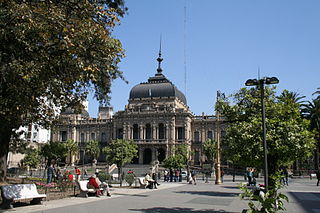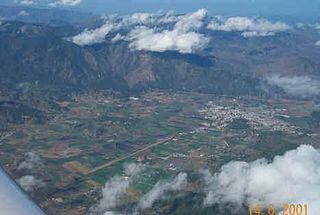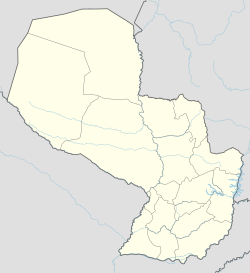
Misiones is one of the 23 provinces of Argentina, located in the northeastern corner of the country in the Mesopotamia region. It is surrounded by Paraguay to the northwest, Brazil to the north, east and south, and Corrientes Province of Argentina to the southwest.

Tucumán is the most densely populated, and the second-smallest by land area, of the provinces of Argentina.

Santiago del Estero is the capital of Santiago del Estero Province in northern Argentina. It has a population of 252,192 inhabitants, making it the twelfth largest city in the country, with a surface area of 2,116 km2. It lies on the Dulce River and on National Route 9, at a distance of 1,042 km north-northwest from Buenos Aires. Estimated to be 455 years old, Santiago del Estero was the first city founded by Spanish settlers in the territory that is now Argentina. As such, it is nicknamed "Madre de Ciudades". Similarly, it has been officially declared the "mother of cities and cradle of folklore."

Río Cuarto is a city in the province of Córdoba, Argentina. Located in the south of the province, it has about 157,000 inhabitants and is an important commercial and agricultural hub.

Francisco Beltrão, established on December 14, 1952, is a municipality in the state of Paraná in Brazil. In 2010, the population was 80,727, of which 85% lived in the city proper and 15% on the surrounding land. Francisco Beltrão is very close to two other cities, Marmeleiro and Renascença. Its economy is based on agriculture, corn crops, turkey and chicken meat exports, textiles, aluminium pans, mobile industries, public services and small commerce.

San Juan Bautista, capital of the Department of Misiones, Paraguay, is considered the cradle of the religious mission culture. The city is the seat of the Roman Catholic Diocese of San Juan Bautista de las Misiones.

Paraguarí is a city, distrito and capital of Paraguarí Department in Paraguay, located 66 km from the country's capital, Asunción. At the 2002 census it had a population of 22,154.

Puerto Iguazú is a border city in the province of Misiones, Argentina. With a population of 82,227 , it is the fourth largest city in the Province, after Posadas, Oberá, and Eldorado.

La Mesopotamia or Región Mesopotámica is the humid and verdant area of northeast Argentina, comprising the provinces of Misiones, Entre Ríos, and Corrientes. The landscape and its characteristics are dominated by two rivers: the Paraná and the Uruguay.

Yaguarón is a city in Paraguay, located at the base of Yaguarón Hill in the Yaguarón District of Paraguarí Department, 48 kilometres (30 mi) from the capital Asunción. The town began as a Franciscan reservation for the Guaraní Indians.

Villeta is a city of Paraguay in the Central Department, on the banks of Paraguay River. It is an important industrial center and port.

Ayolas is a city in the department of Misiones, Paraguay, located at 310 km southeast of Asunción, on the banks of the Paraná River. It is, also, the name of the district within which the city is located.
Caraguatay, Guaraní: Karaguatay) is a distrito and town located in the Vapor Cué region of the Cordillera Department in Paraguay. The livelihood of most citizens includes farming, fishing, and local trading.

Constanza is a town and municipality in La Vega Province, Dominican Republic. Located in the Cordillera Central region, Constanza is known for having the coldest temperature for a settlement on the island of Hispaniola, as well as the entire Caribbean.
Horqueta is a city of Paraguay, in the department of Concepción, located 50 kilometers from Concepción City and 428 kilometers from Asunción. It is established in a hill.

San Juan del Paraná is one of the 30 districts of the Itapúa Department, Paraguay.
Mauricio José Troche is one of the districts in the Guairá department, Paraguay. It is located 183 km away from Asunción, capital of Paraguay.
Lima is a town of the Department of San Pedro Paraguay.

Birkenfeld is an unincorporated community in Columbia County, Oregon, United States, in the Nehalem Valley on Oregon Route 202 between Jewell and Mist.

Due to its vast size and range of altitudes, Argentina possesses a wide variety of climatic regions, ranging from the hot subtropical region in the north to the cold subantarctic in the far south. The Pampas region lies between those and featured a mild and humid climate. Many regions have different, often contrasting, microclimates. In general, Argentina has four main climate types: warm, moderate, arid, and cold in which the relief features, and the latitudinal extent of the country, determine the different varieties within the main climate types.

















